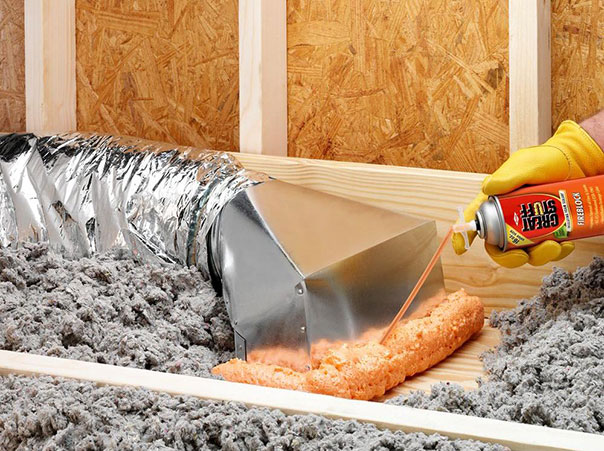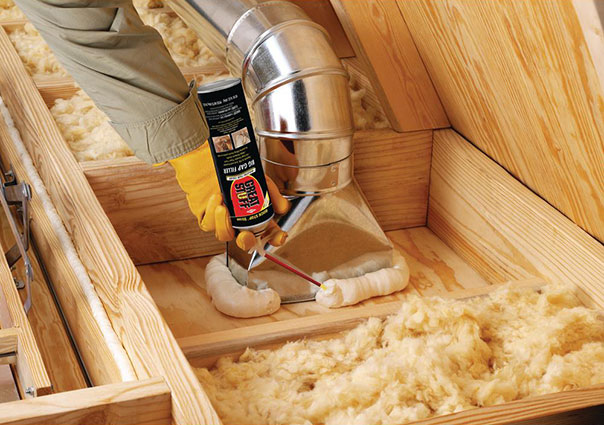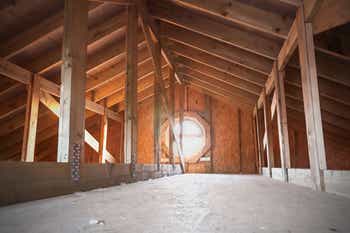Whether your attic needs to be completely insulated or just requires a few extra layers of insulation, doing the necessary prep work will help make the project a success. Without it, your attic will not be as energy-efficient as possible, and you’ll ultimately spend more on heating and cooling costs.

Sealing the small open spaces in your attic will prevent energy loss from airflow.
Complete energy efficiency requires a combination of insulation and air sealing. Insulation slows down the transfer of heat from one object to another, but doesn’t stop energy loss attributed to airflow.
Before installing insulation, first seal any cracks that allow air to flow from the living area into the attic. This prevents moisture-laden air from reaching the attic where it can condense, leading to mold, wet insulation, and possible damage to building components. If your attic already has insulation, you or your contractor will need to move some of it to find the cracks, joints, and holes that need filling.
When you’re in the attic, be careful where you step so that you won’t fall through the drywall ceiling. Place your weight on the joists—don’t step between them. Use kneeboards that span the joists to help distribute your weight. Wear proper safety gear when handling insulation, including a long-sleeved shirt, long pants, work boots, gloves, eye protection, and a dust mask.
Large Openings
Here are two common openings:
- Soffits that open to the attic. It is not unusual for soffits (the exposed eaves on the underside of a structure) on the floor below the attic to be open to the attic. In many cases, a layer of fiberglass insulation covers the soffits, but as mentioned before, insulation cannot stop airflow. To correct the problem, push the insulation aside and attach a layer of rigid foam insulation to the soffit opening. Seal the joints with caulk and then cover them with the same type of insulation that is in the attic.
- Openings around flues and chimneys. Building codes require a space of a few inches between the house framing, and flues and chimneys. Seal the openings of these spaces with a collar fashioned from aluminum flashing. Attach the flashing to the framing and the side of the chimney. Seal all joints using a heat-resistant caulk.
Small Openings

Be sure to seal around any ductwork in the attic.
It can be a challenge to find and seal the many tiny openings in an attic. You will need a flashlight, caulk, and a can of expanding foam insulation to get everything sealed tight. Use the caulk on small openings and the foam for larger areas. The goal is to seal anything that penetrates the floor of the attic. Some things to look for include:
- Open spaces near electrical junction boxes
- Holes for pipes and wiring
- Openings for ductwork
Now is also a good time to seal all ductwork joints using duct mastic or foil-backed tape. Leaky ducts can rob the heating and cooling system of up to 20 percent of its efficiency. The ducts should also be insulated if they are in an unconditioned space.
Finally, don’t forget the attic access hatch. It should be insulated and sealed around the edges.
Recessed Lights
Recessed lights may contribute to a home’s lighting design, but old-fashioned “can” lights in an attic are huge energy wasters. The open spaces around them allow lots of air infiltration, but they aren’t safe to cover with insulation. Instead, replace old lights with insulation contact (IC) fixtures, which can be safely insulated. Caulk the fixture to the ceiling drywall to make it airtight.
Ventilation
Once the living area is sealed off from the attic space, make sure the attic is ventilated properly with eave and ridge vents. Air enters through the eave vents, then rises up and out of the ridge vents. This movement removes any moisture-laden air that finds its way into the attic.
Before you or your contractor start to insulate the attic, make sure the eave vents are kept clear. You can install plastic baffles between the roof rafters to provide a ventilation route.
Attic insulation is essential for saving energy, but it takes a combination of insulation and air sealing to make your home truly energy efficient.
Fran Donegan writes home- and garden-related content for numerous digital and print publications. He is the author of the books Pools and Spas (Creative Homeowner Press) and Paint Your Home (Readers Digest). He also writes about home repair and maintenance for The Home Depot, which carries a wide selection of foam insulation products that you can see here.
By Fran Donegan
This article is editorial content that has been contributed to our site at our request and is published for the benefit of our readers. We have not been compensated for its placement.


